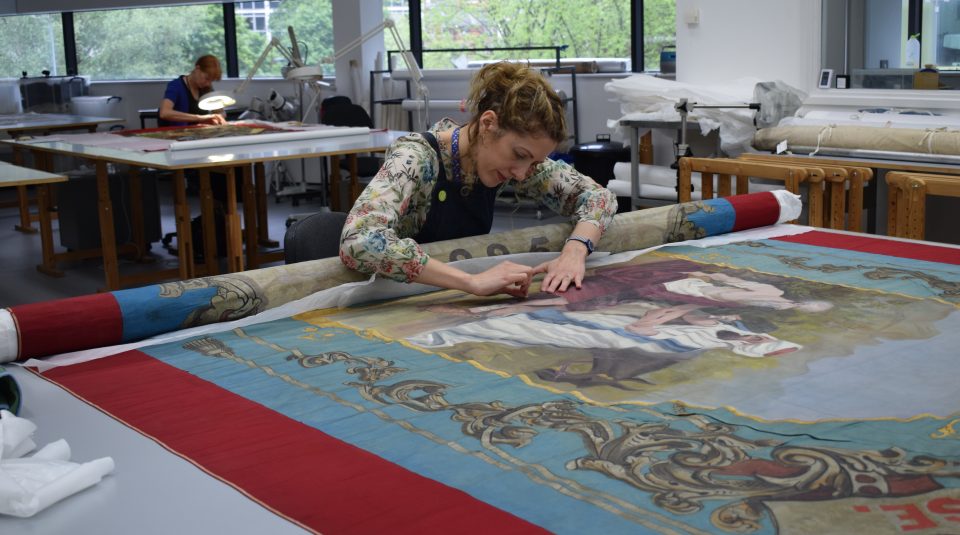



The Downham Benevolent Society, was formed in the 18th century and is an early example of an ‘insurance’ society with the aim to provide benefits in the event of sickness or accident. It is thought to have started in 1795 and commemorated its centenary in 1885 with the unveiling of a large silk banner painted by Joseph Skerret.
The banner was formerly kept in the village church in less than favourable conditions until a community group was established to raise funds and have the banner conserved for future generations. The group were successful in their application to the National Heritage Lottery Fund and the banner came to PHM for conservation in 2016.
 This is a double sided, painted banner, constructed from a single layer of blue silk with red silk borders. The face side image depicts the story of The Good Samaritan from the New Testament Luke 10:23-37 and reflects the message the Benevolent Society wanted to portray, of compassion and generosity regardless of social class. The painting is thought to have been copied from a contemporary print by German artist Siegfried Detlev Bendixen.
This is a double sided, painted banner, constructed from a single layer of blue silk with red silk borders. The face side image depicts the story of The Good Samaritan from the New Testament Luke 10:23-37 and reflects the message the Benevolent Society wanted to portray, of compassion and generosity regardless of social class. The painting is thought to have been copied from a contemporary print by German artist Siegfried Detlev Bendixen.
Overall the banner was quite cockled and distorted from being rolled around its top pole and the surface of the banner was very soiled with dust and other particulates collected while on display in the church.
There was significant light damage, particularly on the blue silk and dark red stitching. Splits has occurred through the blue silk in load bearing points and at the silk, paint interface, this had been repaired over the years with Sellotape which had later caused staining and embrittlement. The lower border corners were also split and repaired which was also causing damage. The paint was stable but very bloomed in places, causing a white haze across the surface.
The plan for treatment was to stabilise the silk areas with a full support and clean the painted sections, remove staining and applying a sleeve to enable the banner to be hung either vertically for limited periods or preferably supported on a sloping b oard.
oard.
Conservation of the banner began with a thorough surface clean using low suction vacuum, brushes and sponges and old adhesive stains were lessened through solvent cleaning. The blue silk was supported with a layer of fine silk crepeline, dyed to match and applied with a conservation grade adhesive in three vertical panels to match the construction of the banner. The borders were less fragile so supported with nylon net also dyed to match and stitched to the borders with silk thread to secure it. The lower border patches were documented before removing and replacing with more sympathetic repairs.